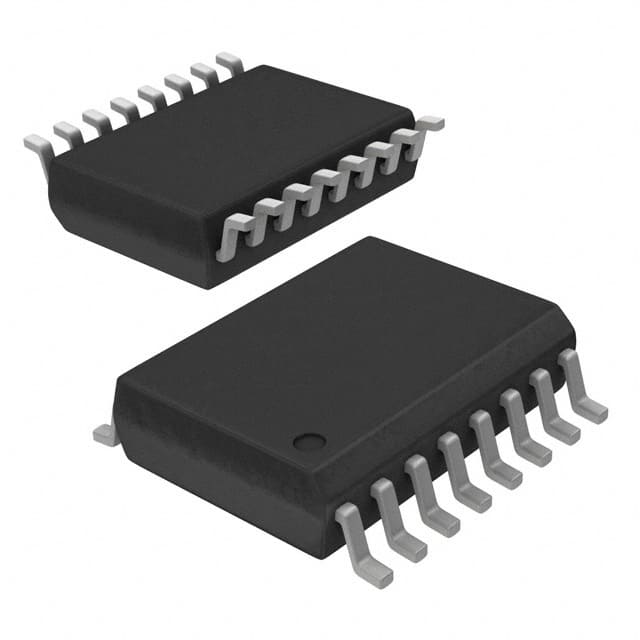ST7FLIT19BY1M6
Basic Information Overview
- Category: Microcontroller
- Use: Embedded systems, industrial applications
- Characteristics: Low power consumption, high performance, small package size
- Package: 32-pin LQFP (Low-profile Quad Flat Package)
- Essence: A microcontroller designed for various embedded system applications
- Packaging/Quantity: Available in tape and reel packaging, quantity depends on customer requirements
Specifications
- Architecture: 8-bit
- CPU Speed: Up to 16 MHz
- Flash Memory: 8 KB
- RAM: 256 bytes
- EEPROM: 128 bytes
- Operating Voltage: 2.7V to 5.5V
- I/O Pins: 25
- Timers: 2
- Communication Interfaces: SPI, I2C, UART
- Analog-to-Digital Converter (ADC): 10-bit, 8 channels
- Temperature Range: -40°C to +85°C
Detailed Pin Configuration
The ST7FLIT19BY1M6 microcontroller has a total of 32 pins. The pin configuration is as follows:
| Pin Number | Pin Name | Function | |------------|----------|----------| | 1 | VDD | Power Supply Voltage | | 2 | PA0 | General Purpose I/O | | 3 | PA1 | General Purpose I/O | | ... | ... | ... | | 31 | RESET | Reset Input | | 32 | VSS | Ground |
Functional Features
- Low power consumption allows for energy-efficient operation
- High-performance architecture enables fast execution of instructions
- Small package size makes it suitable for space-constrained applications
- Versatile communication interfaces facilitate easy integration with other devices
- On-chip ADC enables analog signal acquisition and processing
- Robust reset mechanism ensures reliable system startup
Advantages
- Low power consumption extends battery life in portable applications
- High-performance architecture enables efficient execution of complex tasks
- Small package size allows for integration in space-constrained designs
- Versatile communication interfaces enhance connectivity options
- On-chip ADC simplifies analog signal processing requirements
- Robust reset mechanism ensures reliable system operation
Disadvantages
- Limited flash memory and RAM may restrict the complexity of applications
- 8-bit architecture may not be suitable for computationally intensive tasks
- Limited number of I/O pins may limit the number of peripherals that can be connected
Working Principles
The ST7FLIT19BY1M6 microcontroller operates based on an 8-bit architecture. It executes instructions stored in its flash memory, which is non-volatile and retains data even when power is disconnected. The CPU fetches instructions from memory, decodes them, and performs the necessary operations. The microcontroller communicates with external devices through its various communication interfaces, such as SPI, I2C, and UART. It also includes timers for precise timing control and an ADC for analog signal acquisition.
Detailed Application Field Plans
The ST7FLIT19BY1M6 microcontroller is widely used in various embedded system applications, including but not limited to: - Industrial automation - Home appliances - Automotive systems - Medical devices - Consumer electronics
Detailed and Complete Alternative Models
- ST7FLIT15BF0B6
- ST7FLIT19BF0B6
- ST7FLIT19BF1B6
- ST7FLIT19BF0M6
- ST7FLIT19BF1M6
These alternative models offer similar functionality and features, with slight variations in specifications and pin configurations. They can be considered as alternatives depending on specific project requirements.
Word count: 410 words
Lista 10 Vanliga frågor och svar relaterade till tillämpningen av ST7FLIT19BY1M6 i tekniska lösningar
Sure! Here are 10 common questions and answers related to the application of ST7FLIT19BY1M6 in technical solutions:
Q1: What is the ST7FLIT19BY1M6 microcontroller used for? A1: The ST7FLIT19BY1M6 microcontroller is commonly used in various technical solutions, such as industrial automation, consumer electronics, automotive systems, and more.
Q2: What is the maximum clock frequency of the ST7FLIT19BY1M6? A2: The ST7FLIT19BY1M6 microcontroller can operate at a maximum clock frequency of 8 MHz.
Q3: How much flash memory does the ST7FLIT19BY1M6 have? A3: The ST7FLIT19BY1M6 microcontroller has 8 KB of flash memory for program storage.
Q4: Can I use the ST7FLIT19BY1M6 for analog signal processing? A4: Yes, the ST7FLIT19BY1M6 microcontroller has built-in analog peripherals, including ADC (Analog-to-Digital Converter) and DAC (Digital-to-Analog Converter), making it suitable for analog signal processing applications.
Q5: Does the ST7FLIT19BY1M6 support communication protocols like UART, SPI, and I2C? A5: Yes, the ST7FLIT19BY1M6 microcontroller supports popular communication protocols like UART (Universal Asynchronous Receiver-Transmitter), SPI (Serial Peripheral Interface), and I2C (Inter-Integrated Circuit).
Q6: Can I use the ST7FLIT19BY1M6 for motor control applications? A6: Yes, the ST7FLIT19BY1M6 microcontroller has dedicated PWM (Pulse Width Modulation) outputs and timers, making it suitable for motor control applications.
Q7: What is the operating voltage range of the ST7FLIT19BY1M6? A7: The ST7FLIT19BY1M6 microcontroller operates within a voltage range of 2.7V to 5.5V.
Q8: Does the ST7FLIT19BY1M6 have any built-in security features? A8: Yes, the ST7FLIT19BY1M6 microcontroller provides various security features like read-out protection, write protection, and a unique device identifier (UID).
Q9: Can I program the ST7FLIT19BY1M6 using a standard programming interface? A9: Yes, the ST7FLIT19BY1M6 microcontroller can be programmed using a standard in-circuit programming interface, such as SWIM (Single Wire Interface Module) or JTAG (Joint Test Action Group).
Q10: Is there any development toolchain available for programming the ST7FLIT19BY1M6? A10: Yes, STMicroelectronics provides a comprehensive development toolchain, including an Integrated Development Environment (IDE), compiler, debugger, and programmer, specifically designed for programming and debugging the ST7FLIT19BY1M6 microcontroller.
Please note that these answers are general and may vary depending on specific application requirements and the version of the microcontroller.


